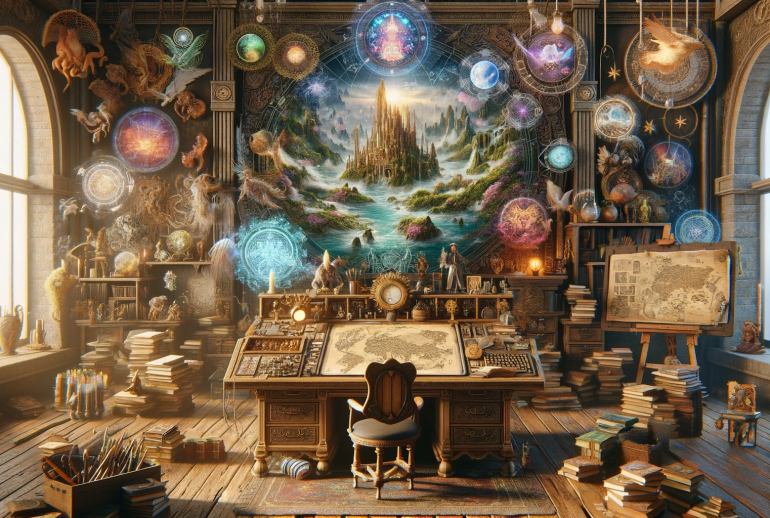In the vast realm of fiction, one of the most enchanting and creative aspects is world-building. Whether you’re crafting a high-fantasy epic, a dystopian future, or a magical realm hidden within our own, the art of world-building allows you to shape entire universes from the ground up. But where do you begin, and what are the essential elements that every writer should consider?
Introduction: The Magic of World-Building
Before we embark on our journey into the world of world-building, let’s understand its significance and the magic it brings to storytelling:
Immersive Experience: World-building transports readers into a new reality, engaging their senses, emotions, and imagination. It allows them to escape into a world where anything is possible.
Character Interaction: The world you create influences your characters’ lives, beliefs, and actions. It shapes their experiences and decisions, driving the narrative forward.
Cohesive Narratives: Thoughtful world-building ensures that your story maintains internal consistency and logic, making it more believable and relatable to readers.
The Foundation of World-Building
To build a compelling fictional world, start with these fundamental building blocks:
1. Geography and Environment:
- Landscapes: Consider the physical features of your world, such as mountains, forests, deserts, and bodies of water.
- Climate: Determine the climate and weather patterns that affect your world, influencing everything from agriculture to clothing.
2. Societal Structures and Cultures:
- Civilizations: Define the societies that inhabit your world. What are their values, customs, and social hierarchies?
- Languages: Create unique languages or dialects to add depth to your cultures.
3. History and Lore:
- Past Events: Develop a rich history with significant events that have shaped your world’s present. These events can be wars, revolutions, or legendary tales.
- Mythology: Craft myths, legends, and religions that provide depth and meaning to your world.
4. Magic and Technology:
- Magic Systems: If your world includes magic, establish rules and limitations for how it works. What can magic do, and what are its costs?
- Technological Advancements: Determine the level of technology in your world, from medieval to futuristic, and how it impacts daily life.
5. Flora and Fauna:
- Flora: Create unique plant life and ecosystems that contribute to your world’s biodiversity.
- Fauna: Design fantastical creatures or unique animal species that inhabit your world.
6. Political Systems:
- Governments: Define the political structures, rulers, and laws governing your societies.
- Conflict and Alliances: Consider past and present conflicts, alliances, and power struggles that shape your world’s political landscape.
7. Economy and Resources:
- Trade and Commerce: Explore trade routes, currencies, and valuable resources within your world.
- Economic Disparities: Examine wealth distribution and disparities among different regions or classes.
8. Daily Life and Technology:
- Housing and Architecture: Describe architectural styles, housing types, and urban planning.
- Transportation: Define methods of transportation, from horses and carriages to advanced vehicles.
9. Belief Systems and Religion:
- Gods and Deities: If religion plays a role, invent gods, goddesses, and belief systems that shape your characters’ faith and values.
- Places of Worship: Design temples, shrines, or sacred sites.
10. Cultural Artifacts: – Art and Artifacts: Describe art forms, clothing, and objects unique to your world, reflecting its cultures and histories. – Literature and Storytelling: Create fictional literature, legends, and tales that reveal your world’s intellectual and creative pursuits.
11. Rules of Magic or Science: – Consistent Laws: Ensure that any magical or scientific laws you introduce remain consistent throughout your narrative. – Limitations: Establish clear limitations to maintain tension and prevent overpowered characters.
12. Maps and Visual Aids: – Cartography: Create maps of your world to help you visualize its geography and layout. – Visual References: Collect images, artwork, or diagrams that inspire your world-building process.
13. Cultural Diversity: – Unique Perspectives: Explore different worldviews, attitudes, and philosophies among your world’s inhabitants.
14. The Unexplained and the Mysterious: – Mysteries: Leave room for unexplained phenomena or hidden secrets within your world, adding intrigue and depth.
15. Evolution and Change: – Dynamic Worlds: Consider how your world evolves and changes over time, whether through natural processes, technological advancements, or supernatural events.
Conclusion: Crafting Worlds of Wonder
World-building is a labor of love, a journey of imagination, and a testament to your creativity as a writer. By carefully considering these fundamental elements and weaving them seamlessly into your narrative, you can create fictional worlds that captivate readers, transport them to new realms, and leave them yearning for more. Embrace the magic of world-building, and let your storytelling reach new heights of wonder and possibility.



